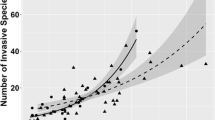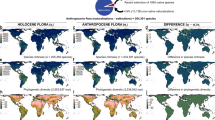Abstract
I conducted surveys of the plant species occupying 136 small islands in the Exuma Cays and 58 small islands near Andros, Bahamas. Most species occurred on relatively few islands, and most islands contained relatively few species. Identities of the most common species differed between the two archipelagos. Comparisons with earlier surveys revealed species extinctions and immigrations. Turnover was relatively low on both a per island and a per species basis on both archipelagos, although significant spatial variation in turnover rates between archipelagos was found. Most islands experienced no turnover; islands on which turnover did occur were larger and had higher species richness. Likewise, most species did not turnover, although much variation existed in turnover rates among those that did. Experimental introductions of two species to very small islands naturally devoid of vegetation revealed that these islands could support plant life. One species survived on eight of ten islands for >9 years, including the effects of a moderate (class 2) hurricane. This hurricane caused substantial damage and loss of plant biomass, but resulted in no species extinctions on 30 small islands. Data for the small islands in this region, now spanning almost a decade, reveal that most populations are persistent over periods of years to decades, rarely going extinct or immigrating. Even moderate hurricanes seem to have little impact on species compositions.





Similar content being viewed by others
References
Abbott I (1977) Species richness, turnover and equilibrium in insular floras near Perth, Western Australia. Aust J Bot 25:193–208
Abbott I (1983) The meaning of z in species/area regressions and the study of species turnover in island biogeography. Oikos 41:385–390
Abbott I, Black R (1980) Changes in species composition of floras on islets near Perth, Western Australia. J Biogeogr 7:399–410
Brown JH, Lomolino MV (1998) Biogeography, 2nd edn. Sinauer, Sunderland, Mass.
Bush MB, Whittaker RJ (1993) Non-equilibration in island theory of Krakatau. J Biogeogr 20:453–457
Correll DS, Correll HB (1982) Flora of the Bahama Archipelago. Cramer, Vaduz
Diamond JM, May RM (1977) Species turnover rates on islands: dependence on census interval. Science 197:266–270
Flood PG, Heatwole H (1986) Coral cay instability and species-turnover of plants at Swain Reefs, Southern Great Barrier Reef, Australia. J Coast Res 2:479–496
Gilbert FS (1980) The equilibrium theory of island biogeography: fact or fiction? J Biogeogr 7:209–235
Gilpin ME, Diamond JM (1976) Calculation of immigration and extinction curves from the species-area-distance relation. Proc Natl Acad Sci USA 73:4130–4134
Gilpin M, Hanski I (eds) (1991) Metapopulation dynamics: empirical and theoretical investigations. Academic Press, London
Hanski I, Gilpin ME (1997) Metapopulation biology: ecology, genetics, and evolution. Academic Press, San Diego, Calif.
Hanski I, Simberloff D (1997) The metapopulation approach, its history, conceptual domain, and application to conservation. In: Hanski IA, Gilpin ME (eds) Metapopulation biology: ecology, genetics and evolution. Academic Press, San Diego, pp 5–26
Heatwole H, Levins R (1973) Biogeography of the Puerto Rican Bank: species-turnover on a small cay, Cayo Ahogado. Ecology 54:1042–1055
Honer D, Greuter W (1988) Plant population dynamics and species turnover on small islands near Karpathos (South Aegean, Greece). Vegetatio 77:129–137
Husband BC, Barrett SCH (1998) Spatial and temporal variation in population size of Eichhornia paniculata in ephemeral habitats: implications for metapopulation dynamics. J Ecol 86:1021–1031
Lack D (1969) The numbers of bird species on islands. Bird Study 16:193–209
Lack D (1976) Island Biology illustrated by the land birds of Jamaica. Blackwell, Oxford
Levins R (1969) Some demographic and genetic consequences of environmental heterogeneity for biological control. Bull Entomol Soc Am 15:237–240
Levins R (1970) Extinction. Lect Math Life Sci 2:75–107
Lynch JF, Johnson NK (1974) Turnover and equilibria in insular avifaunas, with special reference to the California Channel Islands. Condor 76:370–384
MacArthur RH, Wilson EO (1963) An equilibrium theory of insular zoogeography. Evolution 17:373–387
MacArthur RH, Wilson EO (1967) The theory of island biogeography. Princeton University Press, Princeton
Morrison LW (1997) The insular biogeography of small Bahamian cays. J Ecol 85:441–454
Morrison LW (1998) The spatiotemporal dynamics of insular ant metapopulations. Ecology 79:1135–1146
Morrison LW (2002) Island biogeography and metapopulation dynamics of Bahamian ants. J Biogeogr 29:387–394
Nellis DW (1994) Seashore plants of South Florida and the Caribbean. Pineapple, Sarasota, Fla.
Nilsson IN, Nilsson SG (1982) Turnover of vascular plant species on small islands in Lake Mockeln, South Sweden 1976–1980. Oecologia 53:128–133
Nilsson SG, Nilsson IN (1983) Are estimated species turnover rates on islands largely sampling errors? Am Nat 121:595–597
Nilsson IN, Nilsson SG (1985) Experimental estimates of census efficiency and pseudoturnover on islands: error trend and between-observer variation when recording vascular plants. J Ecol 73:65–70
Ouborg NJ (1993) Isolation, population size and extinction: the classical and metapopulation approaches applied to vascular plants along the Dutch Rhine-system. Oikos 66:298–308
Perry JN, Gonzalez-Andujar JL (1993) Dispersal in a metapopulation neighbourhood model of an annual plant with a seedbank. J Ecol 81:453–463
Rogers RW, Morrison D (1994) Floristic change on Heron Island, a coral cay in the Capricorn-Bunker Group, Great Barrier Reef. Aust J Bot 42:297–305
Rosenzweig ML (1995) Species diversity in space and time. Cambridge University Press, Cambridge
Russell GJ, Diamond JM, Pimm SL, Reed TM (1995) A century of turnover: community dynamics at three timescales. J Anim Ecol 64:628–641
Schoener TW (1987) Leaf pubescence in buttonwood: Community variation in a putative defense against defoliation. Proc Natl Acad Sci USA 84:7992–7995
Schoener TW (1988) On testing the MacArthur-Wilson model with data on rates. Am Nat 131:847–864
Sealey NE (1985) Bahamian landscapes. Collins Caribbean, London
Spiller DA, Losos JB, Schoener TW (1998) Impact of a catastrophic hurricane on island populations. Science 281:695–697
Valverde T, Silvertown J (1997) A metapopulation model for Primula vulgaris, a temperate forest understorey herb. J Ecol 85:193–210
Vidal E, Medail F, Tatoni T, Bonnet V (2000) Seabirds drive plant species turnover on small Mediterranean islands at the expense of native taxa. Oecologia 122:427–434
Whittaker RJ (1995) Disturbed island ecology. Trends Ecol Evol 10:421–425
Whittaker RJ (1998) Island biogeography. Oxford University Press, Oxford
Whittaker RJ, Field R, Partomihardjo T (2000) How to go extinct: lessons from the lost plants of Krakatau. J Biogeogr 27:1049–1064
Williamson MH (1981) Island populations. Oxford University Press, Oxford
Williamson M (1989) The MacArthur and Wilson theory today: true but trivial. J Biogeogr 16:3–4
Acknowledgements
This work was supported by a National Geographic Society grant (6145–98) to the author, and NSF grants to T. W. Schoener and D.A. Spiller. I thank Desire E. Sasko of the Perry Institute for Marine Science Caribbean Marine Research Center for providing rainfall data. T.W. Schoener and G.J. Russell provided helpful comments on a previous version of the manuscript.
Author information
Authors and Affiliations
Corresponding author
Appendix
Appendix
Plant species found on small islands in the Exumas and near Androsa. P Proportion of islands on which each species was present in 1998 (Exumas) or 1999 (Andros)b; T relative turnover (% year−1), calculated on a per species basis
Species | Exumas | Andros | ||
|---|---|---|---|---|
P | T | P | T | |
AIZOACEAE | ||||
Sesuvium portulacastrum L. | 53.8 | 0 | 28.3 | 20 |
AMARANTHACEAE | ||||
Caraxeron vermicularis (L.) | 2.2 | 0 | ||
AMARYLLIDACEAE | ||||
Hymenocallis arenicola Northrop | 2.2 | 33.33 | ||
ANACARDIACEAE | ||||
Metopium toxiferum (L.) King & Urb. | 4.7 | 0 | ||
APOCYNACEAE | ||||
Echites umbellata Jacq. | 2.2 | 0 | ||
ASTERACEAE | ||||
Borrichia aborescens (L.) DC. | 67.0 | 0 | 34.8 | 0 |
Salmea petrobioides Griseb. | 0.9 | 0 | 4.3 | 0 |
AVICENNIACEAE | ||||
Avicennia germinans (L.) L. | 10.4 | 0 | 73.9 | 1.45 |
BATACEAE | ||||
Batis maritima L. | 2.2 | 0 | ||
BORAGINACEAE | ||||
Bourreria ovata Miers | 0.9 | 0 | ||
Cordia sebestena L. | 6.6 | 0 | ||
Mallotonia gnaphalodes (L.) Britt. | 7.5 | 5.88 | ||
CACTACEAE | ||||
Cephalocereus millspaughii Britt. | 0 | 100.00 | ||
Opuntia stricta Haw. | 0 | 100.00 | ||
CAPPARACEAE | ||||
Capparis flexuosa (L.) L. | 4.7 | 0 | ||
CASUARINACEAE | ||||
Casuarina equisetifolia L. | 1.9 | 0 | 8.7 | 0 |
CELASTRACEAE | ||||
Cassine xylocarpa Vent. | 0 | 100.00 | ||
Crossopetalum rhacoma Crantz | 0.9 | 0 | ||
CHENOPODIACEAE | ||||
Salicornia virginica L. | 0.9 | 0 | 2.2 | 33.33 |
COMBRETACEAE | ||||
Conocarpus erectus L. | 67.0 | 0 | 45.6 | 0 |
Laguncularia racemosa (L.) Gaertn. f. | 3.8 | 0 | 69.9 | 0 |
CONVOLVULACEAE | ||||
Ipomoea violacea L. | 3.8 | 0 | ||
Jaquemontia havanensis (Jacq.) Urb. | 1.9 | 50 | ||
CYPERACEAE | ||||
Cyperus sp. | 0.9 | 0 | ||
Cyperus planifolius Rich. | 8.5 | 0 | ||
Fimbristylis spadicea (L.) Vahl | 0.9 | 0 | ||
EUPHORBIACEAE | ||||
Ateramnus lucidus (Sw.) Rothm. | 1.9 | 20.00 | 0 | 100.00 |
Drypetes diversifolia Krug & Urb. | 2.8 | 0 | ||
Euphorbia boddgettii Englem. ex. Hitchc. | 0.9 | 0 | ||
Euphorbia mesembrianthemifolia Jacq. | 1.9 | 0 | ||
GOODENIACEAE | ||||
Scaevola plumieri (L.) Vahl | 10.4 | 0 | ||
GRAMINEAE | ||||
Eustachys petraea (Sw.) Desv. | 0.9 | 0 | ||
Paspalum blodgettii Chapm. | 0.9 | 0 | ||
Paspalum distichum L. | 2.8 | 0 | 28.3 | 3.70 |
Spartina patens (Ait.) Muhl. | 10.4 | 0 | 28.3 | 0 |
Sporobolus virginicus (L.) Kunth | 8.5 | 0 | ||
Uniola paniculata L. | 1.9 | 0 | ||
LEGUMINOSAE | ||||
Canavalia rosea (Sw.) DC. | 0.9 | 0 | ||
Lysiloma latisiliquum (L.) Benth. | 0.9 | 0 | ||
Pithecellobium keyense Britt. ex Britt. & Rose | 15.1 | 0 | 17.4 | 0 |
Sophora tomentosa L. | 10.4 | 0 | 13.0 | 14.29 |
MALVACEAE | ||||
Thespesia populnea (L.) Soland. ex Correa | 2.2 | 0 | ||
NYCTAGINACEAE | ||||
Guapira discolor (Spreng.) Little | 8.5 | 5.88 | 4.3 | 0 |
OLEACEAE | ||||
Forestiera segregata (Jacq.) Krug & Urb. | 10.9 | 0 | ||
PALMAE | ||||
Coccothrinax argentata (Jacq.) L. H. Bailey | 7.5 | 0 | ||
Cocos nucifera L. | 2.2 | 100.00 | ||
POLYGONACEAE | ||||
Coccoloba diversifolia Jacq. | 9.4 | 5.26 | 2.2 | 0 |
Coccoloba uvifera (L.) L | 9.4 | 5.26 | 20.0 | 5.27 |
RHAMNACEAE | ||||
Reynosia septentrionalis Urb. | 15.1 | 0 | 13.0 | 0 |
RHIZOPHORACEAE | ||||
Rhizophora mangle L. | 10.4 | 23.81 | 80.4 | 8.57 |
RUBIACEAE | ||||
Antirhea myrtifolia (Griseb.) Urb. | 0.9 | 0 | ||
Casasia clusiifolia (Jacq.) Urb. | 23.6 | 0 | 8.7 | 14.29 |
Erithalis fruticosa L. | 15.1 | 6.66 | 8.7 | 0 |
Ernodea littoralis Sw. | 1.9 | 0 | ||
Neolaugeria densiflora (Griseb.) Nicholson | 6.5 | 20 | ||
Rhachicallis americana (Jacq.) O. Ktze. | 91.5 | 0 | 30.4 | 0 |
Strumpfia maritima Jacq. | 14.2 | 0 | 4.3 | 0 |
SAPOTACEAE | ||||
Bumelia americana (Mill.) Stearn | 8.5 | 5.88 | 10.9 | 0 |
Manilkara bahamensis (Baker) Lam. & Meeuse | 17.0 | 0 | 15.2 | 0 |
SMILACACEAE | ||||
Smilax auriculata Walt. | 5.7 | 9.09 | ||
Smilax havanensis Jacq. | 2.8 | 0 | 2.2 | 0 |
SOLANACEAE | ||||
Solanum bahamense L. | 0.9 | 0 | ||
SURIANACEAE | ||||
Suriana maritima L. | 42.5 | 2.27 | 21.7 | 0 |
THEOPHRASTACEAE | ||||
Jacquinia keyensis Mez | 8.5 | 11.11 | 2.2 | 0 |
Rights and permissions
About this article
Cite this article
Morrison, L.W. Plant species persistence and turnover on small Bahamian islands. Oecologia 136, 51–62 (2003). https://doi.org/10.1007/s00442-003-1252-1
Received:
Accepted:
Published:
Issue Date:
DOI: https://doi.org/10.1007/s00442-003-1252-1




